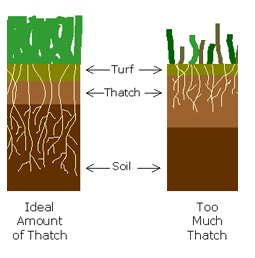Lawn Fertilization the Key to a Healthy Lawn Diet by Lawn Doctor
You just finished a heavy meal, and wondered to yourself if...
Posted on September 19, 2024 by Lawn Doctor
Have you ever come cross a beautiful crisp, green lawn during the fall season? High chances, that lawn was aerated in order to of achieve that nice appearance. Fall is the best time to aerate your lawn in order to help recover from summer stress. Use the following tips and advice below to understand the procedure of lawn aeration.
Lawn aeration is the process of removing plugs of soil to alleviate soil compaction and allow oxygen, nutrients, and water to go into the root area. By allowing oxygen, nutrients, and water into the root zone, your lawn can grow and produce stronger roots. If the soil is compacted (in a solid-form compressed with no small holes), your lawn will not be able to receive those important nutrients and moisture it needs for that nice fall appearance.
Aerating your lawn periodically can positively impact the overall health of the soil and the plants that grow there. Given that this is another potential yard chore or something you may need to pay a pro to do, is law aeration worth it? Consider the five benefits below to decide for yourself whether you should aerate your lawn.
Over time, the density of soil in your yard can increase. Highly compacted soil is not an ideal environment for all plants, as the dense soil keeps nutrients, water and air from appropriately infiltrating root systems. This can lead to issues like generally poor lawn health or dry or dying patches of grass.
When you aerate your lawn, you remove cores of soil, making room for the remaining soil to expand. That helps ensure plant root systems get what they need for optimal health.

Thatch is a layer of living and dead materials that forms between the grass blades and soil surface. If you see a layer of compressed soil with heavy rocks, and stones, thatch may have formed within that area. Excessive amount of thatch can lead to lawn diseases and increased insect activity.
Lawn aeration helps relieve thatch by returning soil to the thatch layer. Soil contains tiny animals called microbes. These tiny animals eat the thatch layer which helps eliminate a place where insects and disease often live. Thatch interferes with the root development and blocks out movement for oxygen, nutrients, and water. If you see your lawn with large areas of thatch, you will need lawn aeration in order to clear out the soil compaction.
Compacted soil can make it more difficult for rainwater to penetrate the surface. This means vital moisture doesn’t make it down to plant roots, but it can also create some surface-level problems. Water that doesn’t seep into the ground can puddle on the surface, creating muddy areas in your yard. It can also run off, taking valuable topsoil and nutrients with it into ditches or other locations. Aeration loosens the soil and creates a path down for water, mitigating some of these issues.
Loosening the soil around grass and other plants creates a space for growing root strength. Beneficial organisms, such as worms, can move better in the soil, and the roots themselves can interact better with what’s around them. All of this leads to more dynamic root systems that support health for entire yards and gardens.
By encouraging deeper, healthier root systems for grass and other wanted plants in your yard, you decrease the chance that weeds can gain a foothold and thrive in your yard. This is one way to get rid of weeds using a more natural approach.
Here are other signs to help identify if lawn aeration is needed to achieve your dream lawn appearance this fall:
When and how often you should aerate your lawn depends on your goals, the type of soil you have and other factors. If you aerate your lawn annually, the season you choose matters. Cool-season grass like ryegrass or bluegrass is best aerated in early fall or early spring. Warm-season grass like buffalo grass or Bermuda grass is best aerated in early summer or late spring.
The type of grass you have typically depends on where you live. Cool-season grass is usually found in areas that experience hot summers and cold winters. Warm-season grass is usually found in areas that have mostly warm climates, such as the southern part of the United States. If you’re not sure what type of grass you have in your yard, consider discussing care needs and aeration best practices with a professional.
Lawn aeration is done with a specialized piece of equipment called the lawn aerator. Due to the equipment’s heavy weight, we suggest calling your local Lawn Doctor to schedule an appointment for our lawn aeration service. Remember, you could be spending valuable time playing golf, fishing, or out with family and friends than having the hassle of going to the rental store and bringing a heavy piece of equipment home. Call Lawn Doctor today.
Contact Lawn Doctor to help care for your lawn when you can’t.
You just finished a heavy meal, and wondered to yourself if...
The last thing you want when you are about to...